14 Bizarre And Fascinating Philippine Festivals
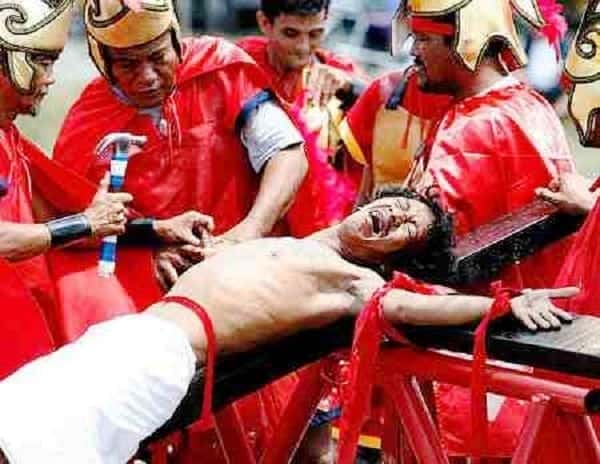
Filipinos love to party, that’s a fact. Whether it be for a religious occasion, a charter day, etc., we will find a reason to celebrate. From the biggest cities down to the smallest barangays, there is always a scheduled time for a fiesta.
Notwithstanding the sheer number of festivals celebrated across the country, some do stand out for being different. It’s fine though, as those differences exemplify the diversity of Filipino culture.
Also Read: 7 Things You’ll Only See in the Philippines
Let’s find out more about these odd festivals and where and when they are being celebrated. Who knows, maybe we’ll even get to celebrate them ourselves someday.
1. Turogpo Festival (Carigara, Leyte).
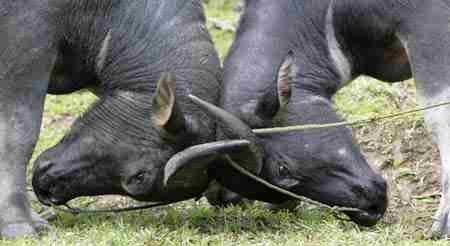
Held every March 22 or Black Saturday, the event features cockfights, horse-fights, and the odder carabao-fights. First started in the 1600s, the festival—and the animal jousts in particular—were seen as the Filipinos’ subtle way of protesting against Spanish rule.
Related Article: Horse-fighting (and other shocking old practices Filipinos still do today!)
Presently, the festival continues to see an influx from tourists—and animal activists—for its strange attractions.
2. Katigbawan Festival (Catigbian, Bohol).
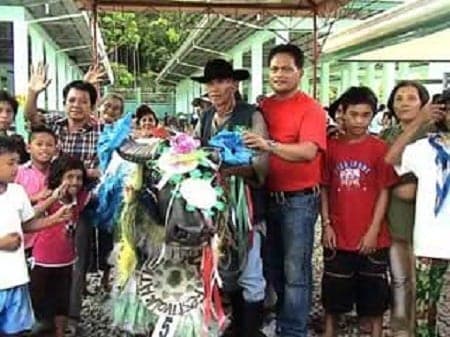
Celebrated every June 17 and lasting for a week, the Katigbawan Festival is a thanksgiving festival to commemorate Catigbian’s founding.
Also Read: Top 10 Weirdest Philippine Animals
Aside from the standard local beauty contest involving humans, the festival also has a carabao pageant; in this contest, carabaos are dressed and are given a chance to showcase their “talents,” with the winners getting a prize in the end. This is the townspeople’s way of honoring the animal seen as the best friend of all farmers.
3. Baliw-Baliw Festival (Olango Island, Cebu).
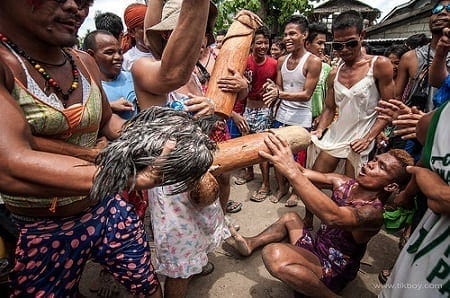
Held every May—particularly on the date with the highest 12-noontide—to honor San Vicente Ferrer, the celebration features a variety of oddities including cross-dressing men, the simulation of giving birth by said men in the sea, people wearing or carrying phallic symbols, inter-animal fights (roosters, cats, and even kittens and frogs are used), and selling of cow manure topped with ketchup.
Recommended Article: 0 Amazing Facts You Probably Didn’t Know About Cebu
No one really knows when the festival began although the older ones say it was first celebrated during the 18th century or even earlier than that. Due to the pagan undertones, the local Catholic Church even banned the festivities for a while; nowadays, it is still being celebrated though and is defended by the devotees as a plea to their patron saint for help in coping with life’s madness.
4. Lukayo Festival (Kalayaan, Laguna).
READ: 10 Reasons Why Life Was Better In Pre-Colonial Philippines
The ritual is performed by outrageously dressed women who wave around wooden phalluses, eggplants or any other depictions of the male organ and sing innuendo-filled songs on the couple’s wedding day. Although it might look malicious, anthropologist and National Artist Ramon Obusan says the ritual also symbolizes women’s empowerment against male domination by way of satirizing the phallus, the male symbol of power.
5. Obando Fertility Rites (Obando, Bulacan).
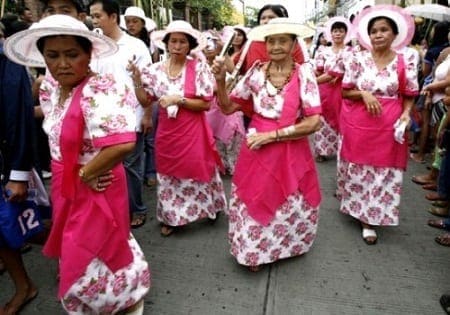
Usually celebrated from May 17 to 19, the Obando Fertility Rites traces its roots back to pre-Spanish times when pagan natives would celebrate it in hopes of having children or getting a good harvest.
READ: Top 10 Pinoy Health Myths You Thought Were True
Nowadays, the festival is a mix of pagan and Roman Catholic beliefs, with San Pascual de Baylon, Sta. Clara and the Lady of Salambao replacing the old idols as the central figures. Childless couples and singles looking for their soulmates can do the fertility dance in front of San Pascual and Sta. Clara; fisher and farm-folk meanwhile can dance to the Lady of Salambao for a good season.
6. Feast of Sta. Marta de Pateros (Pateros, Manila).
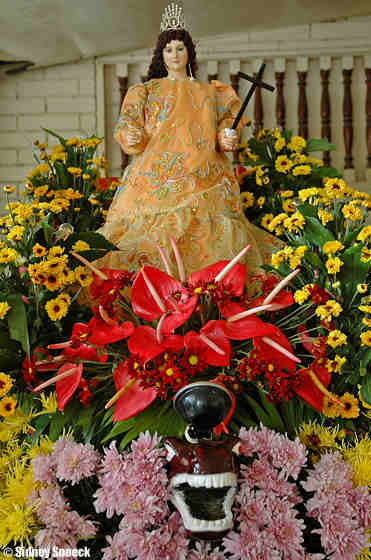
Photo Credit: Sidney Snoeck via My SariSari Store
While it may look ordinary, a closer look at the Feast of Sta. Marta in Pateros–which is usually celebrated by the people every second Sunday of February—reveals a colorful backstory.
According to tradition, the festival began during the Spanish era when the townspeople made a plea to the lady saint after a huge crocodile living in the river began eating their ducks which were the source of their livelihood. Frustrated after they couldn’t catch the croc, the townspeople sought the advice of the priest who told them to pray to Sta. Marta. After they did, an unknown man succeeded in killing the crocodile and was hailed as a hero.
Also Read: 7 Most Unintentionally Terrifying Statues In The Philippines
In gratitude, the people made Sta. Marta their patron saint; today, her statue depicts her stepping on a crocodile.
7. Aswang Festival (Roxas City, Capiz).

Started in 2004, the Aswang Festival showcased the country’s most famous monsters and was held on October 29 until October 30.
Organizers of the festival, Dugo Capiznon, hoped to change people’s perception of Capiz as a haven for aswang and instead use the mythical creatures as a tourist attraction, which is why the parade was made up of people dressed in various monster costumes.
Related Article: Top 10 Lesser-Known Mythical Creatures in Philippine Folklore
Unfortunately, the festival was shut down in 2007 due to strong pressure by the Catholic Church who feared the festival could sway people towards evil.
8. Mayohan Sa Tayabas (Tayabas City, Quezon).
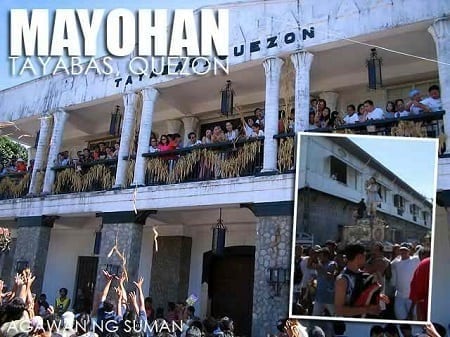
Want free suman? Then head on over to and enjoy the Mayohan sa Tayabas.
A festival which lasts from May 6 to 15, the Mayohan is the townspeople’s way of showing their devotion to San Isidro Labrador, the patron saint of farmers. The celebration is also meant to symbolize the people’s gratitude for the previous year’s blessings and their hopefulness for the same in the future.
Recommended Article: 35 Outrageous Filipino Superstitions You Didn’t Know Existed
The highlight of the festival itself comes during the last day with the Hagisan ng Suman—an activity wherein the people throw suman, foodstuffs, and other items down towards a procession carrying the statue of San Isidro Labrador as it parades around the city. It is believed anyone who catches the items will have a good year ahead.
9. Rodeo Masbateño (Masbate City, Masbate).
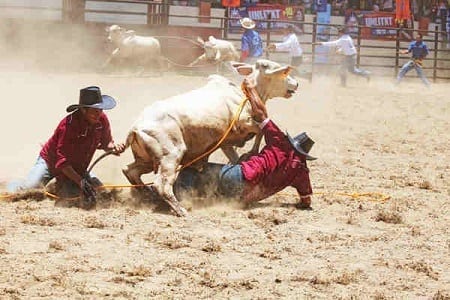
For those who want to see a Western-style rodeo with a Pinoy twist, there’s the famous Rodeo Masbateño, a five-day festival held right in the heart of the country’s Cattle Capital every April and which was started in 1993 by a group of ranchers.
Also Read: 8 Dark Chapters of Filipino-American History We Rarely Talk About
Said to be the province’s biggest event, the festival really has the feel of a real rodeo too. Events range from the quintessential cow-wrestling, lassoing, to the more-Filipino calesa rides. Of course, there are also cattle parades, barn dances, and livestock shows.
Apparently, the festival’s popularity even led former President Gloria Arroyo to issue an order declaring Masbate as the country’s Rodeo Capital.
10. Taong Putik Festival (Aliaga, Nueva Ecija).
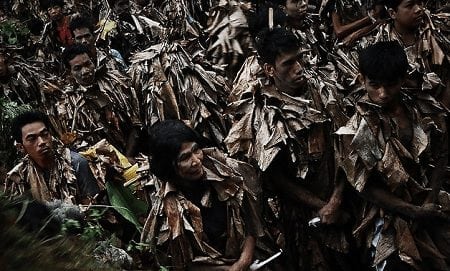
While many of us would usually commemorate St. John the Baptist‘s Day (June 24) by just dousing each other with water, the people of Aliaga, Nueva Ecija, take it up a notch and drench their bodies with mud and cover themselves in vines and banana leaves before joining the procession dedicated to the saint.
The practice is said to have started during World War II when the Japanese were about to execute all the male residents in revenge for an earlier guerrilla ambush. Just as the execution was about to start, it began to rain heavily. The Japanese took the downpour as an ominous sign and set their prisoners free.
READ: 10 Biggest Misconceptions About World War II In The Philippines
The jubilant villagers attributed this miracle to St. John the Baptist and celebrated by rolling in the mud. Since then, the townspeople have celebrated June 24 in that fashion.
11. Parada ng Lechon (Balayan, Batangas).
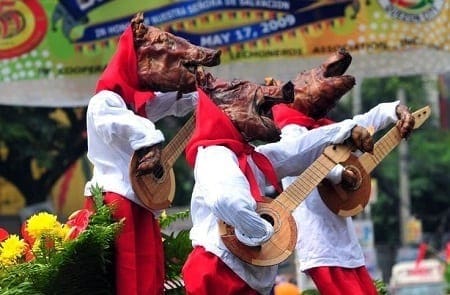
While there are undoubtedly many “lechon festivals” across the country (Pinoys have a love affair with pork after all), the people of Balayan, Batangas probably enjoy an edge with their world-class Parada ng Lechon.
READ: Top 10 Most Bizarre Filipino Foods
The festival—which also commemorates St. John the Baptist—sees hundreds of roasted pigs being paraded in the streets every year on June 24. Some are adorned with costumes, while others have their heads removed and placed on mannequins. At the end of the procession, the roasted pigs are usually brought to the local church and blessed; afterward, they are distributed to the public for consumption.
12. Piestang Tugak (San Fernando City, Pampanga).
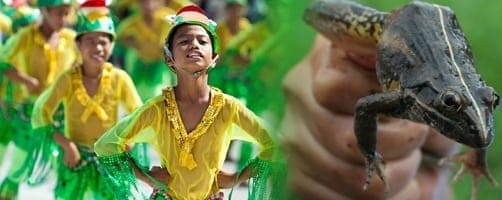
Forget carabaos and pigs—the people of San Fernando prefer frogs, hence the existence of the Piestang Tugak.
First organized in 2003, the frog-themed festival held every first week of October is meant to showcase the importance of frogs to the culture of Pampanga, especially to that of the Fernandinos. Attractions include traditional frog-catching contests, frog-based cuisine such as stuffed frog, and other fun and games involving the beloved amphibians.
13. Bagoong Festival (Lingayen, Pangasinan).
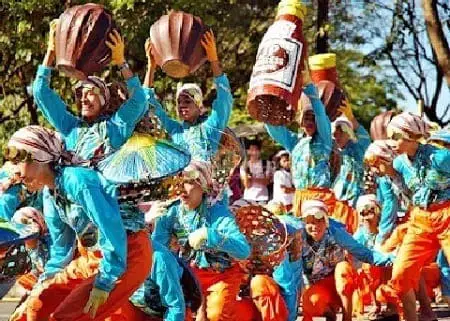
Salted fish/shrimp paste as the theme for a festival? While it may sound strange, the people of Lingayen have celebrated the Bagoong Festival three straight years now (the first one in 2011) as a way to celebrate their main source of livelihood. You can watch dancers wearing shrimp costumes or those with bagoong bottles as they sashay away in the streets.
14. San Pedro Cutud Lenten Rites (San Fernando City, Pampanga).
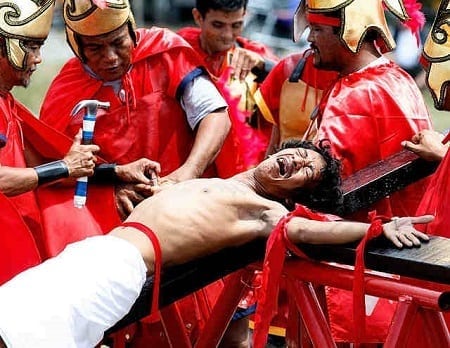
Said to have started during the 1950s and held every Good Friday, penitents of this barangay would line the streets and strike their backs bloody with sharpened bamboo whips. The gory spectacle does not stop there, however, as three devotees would re-enact the crucifixion of Jesus Christ and the two thieves by being actually crucified with nails on a cross in a field near the barangay.
Also Read: 7 Myths About Spanish Colonial Period Filipinos Should All Stop Believing
As to why they engage in such a practice, the participants say they do it in imitation of Christ’s suffering and as a form of penance. Due to the bloody nature of the event, the Rites have attracted both local and foreign tourists eager to see the penitents’ almost-fanatical devotion to their faith.
References
Cardinoza, G. (2014). ‘Bagoong’ makes Lingayen townsfolk dance. Inquirer.net. Retrieved 11 February 2015, from http://goo.gl/QE7ULd
City of Tayabas Official Website,. Mayohan sa Tayabas. Retrieved 11 February 2015, from http://goo.gl/KKvsnP
Darang, J. (2007). Pateros’ powerful patron saint. Inquirer.net. Retrieved 11 February 2015, from http://goo.gl/zF9JD5
Domanguera, G. (2014). Men Wearing Women’s Clothing at Baliw-baliw Festival in Olango.ZeroThreeTwo. Retrieved 11 February 2015, from http://goo.gl/8te1iv
Fariola-Ruedas, J. (2009). Leyte holds Turogpo Festival. ABSCBNNews.com. Retrieved 11 February 2015, from http://goo.gl/1SbdIO
Galang, A. (2013). ‘Taong putik’ immortalized in Ecija shrine. Inquirer.net. Retrieved 11 February 2015, from http://goo.gl/GHnmjP
GMA News Online,. (2006). Church wants to stop ‘Aswang Festival’ in Capiz. Retrieved 11 February 2015, from http://goo.gl/3XzUt3
Lago, A. (2013). Masbate’s cowboy festival: Pinoy and wildly western at the same time. GMA News Online. Retrieved 11 February 2015, from http://goo.gl/MjjVfo
The PCIJ Blog,. (2006). Old women playing with wooden dicks: How ‘i-Witness’ got into trouble with the censors. Retrieved 11 February 2015, from http://goo.gl/Fwdz3C
Udtohan, L. (2007). 3rd Katigbawan Festival: Carabaos are ‘beauty queens’. Bohol.ph. Retrieved 11 February 2015, from http://goo.gl/jGiC6V
FilipiKnow
FilipiKnow strives to ensure each article published on this website is as accurate and reliable as possible. We invite you, our reader, to take part in our mission to provide free, high-quality information for every Juan. If you think this article needs improvement, or if you have suggestions on how we can better achieve our goals, let us know by sending a message to admin at filipiknow dot net
Copyright Notice
All materials contained on this site are protected by the Republic of the Philippines copyright law and may not be reproduced, distributed, transmitted, displayed, published, or broadcast without the prior written permission of filipiknow.net or in the case of third party materials, the owner of that content. You may not alter or remove any trademark, copyright, or other notice from copies of the content. Be warned that we have already reported and helped terminate several websites and YouTube channels for blatantly stealing our content. If you wish to use filipiknow.net content for commercial purposes, such as for content syndication, etc., please contact us at legal(at)filipiknow(dot)net
